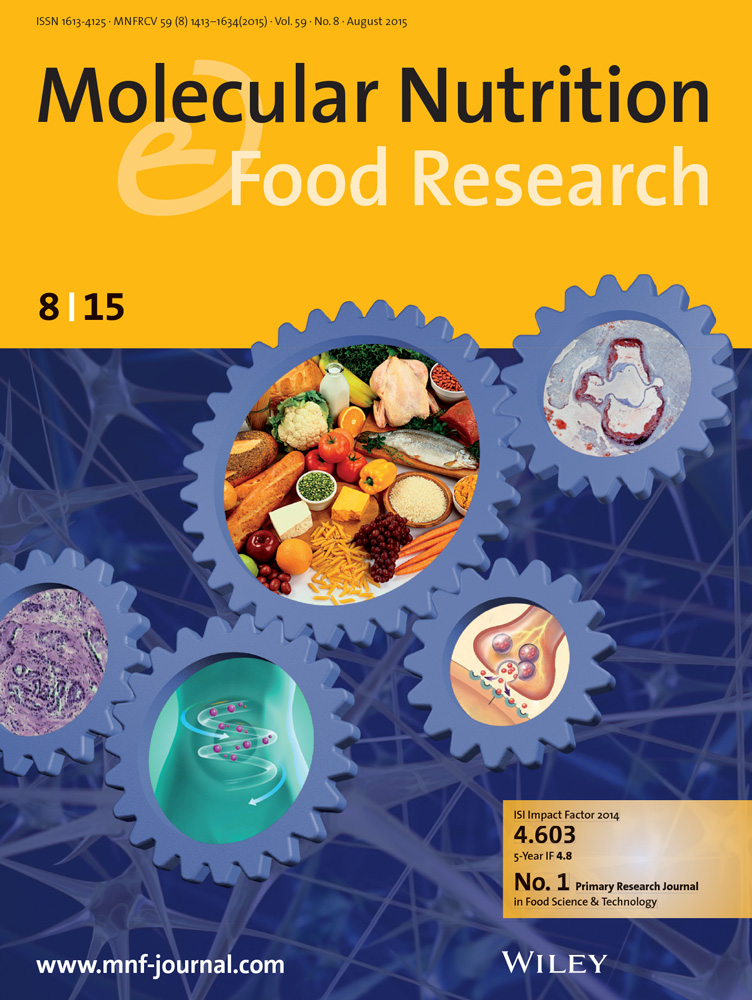野生蓝莓(多)酚代谢物在调节3T3-L1脂肪细胞脂质代谢和氧化应激中的差异作用
IF 4.5
2区 农林科学
Q1 FOOD SCIENCE & TECHNOLOGY
引用次数: 0
摘要
由脂质积累引起的脂肪细胞肥大在肥胖的发展中起着至关重要的作用。野生蓝莓;多酚(PPs)代谢物可能调节脂肪形成和肥胖的发生。本研究探讨了WB PP代谢物对成熟3T3-L1脂肪细胞脂质积累、脂质代谢和氧化应激的影响。用游离脂肪酸(FFAs)处理分化的3T3-L1脂肪细胞48小时;油酸/棕榈酸750µM, 2:1比例)和wb衍生PPs,包括阿魏酸(FA)、异阿魏酸(IA)、香草酸(VA)和丁香酸(SA)生理和超生理浓度。评估包括脂质积累、甘油释放、脂质代谢标志物(固醇调节元件结合蛋白1c [SREBP-1]、脂肪酸合成酶[FASN]、FAB4)和氧化应激(DNA损伤、8-羟基2-脱氧鸟苷[8OHdG]、核红细胞因子2相关因子2 (NRF2)、血红素加氧酶1 [HO-1])。FFAs显著增加脂质积累、甘油释放和FASN水平,同时降低HO-1水平,但不影响其他标志物。WB PP代谢物没有降低脂质积累,但IA和VA降低了FASN水平(- 25%和- 26%;p & lt;0.05), SA可提高HO-1水平(+150%;p & lt;0.05)。尽管观察到的效果不同,但在我们的实验条件下获得的结果似乎表明,IA、VA和SA可能调节脂质代谢和氧化应激标志物。然而,需要进一步的研究来证实这些发现,并支持这些BB PPs代谢物和其他化合物在预防和控制肥胖中的作用。本文章由计算机程序翻译,如有差异,请以英文原文为准。

Differential Effects of Wild Blueberry (Poly)Phenol Metabolites in Modulating Lipid Metabolism and Oxidative Stress in 3T3-L1 Adipocytes
Adipocyte hypertrophy, driven by lipid accumulation, is crucial in the development of obesity. Wild blueberry (WB; Vaccinium angustifolium) (poly)phenols (PPs) metabolites may modulate adipogenesis and the development of obesity. This study examines WB PP metabolites’ effects on lipid accumulation, lipid metabolism, and oxidative stress in mature 3T3-L1 adipocytes. Differentiated 3T3-L1 adipocytes were treated for 48 h with free fatty acids (FFAs; oleic/palmitic acid 750 µM, 2:1 ratio) and WB-derived PPs, including ferulic acid (FA), isoferulic acid (IA), vanillic acid (VA), and syringic acid (SA) at physiological and supra-physiological concentrations. Assessments included lipid accumulation, glycerol release, and markers of lipid metabolism (sterol regulatory element-binding protein 1c [SREBP-1], fatty acid synthase [FASN], FAB4) and oxidative stress (DNA damage, 8-hydroxy 2-deoxyguanosine [8OHdG], nuclear erythroid factor 2-related factors 2 (NRF2), heme oxygenase 1 [HO-1]). FFAs significantly increased lipid accumulation, glycerol release, and FASN levels, while reducing HO-1 levels, without affecting other markers. WB PP metabolites did not reduce lipid accumulation, but IA and VA reduced FASN levels (−25% and −26%; p < 0.05), and SA improved HO-1 levels (+150%; p < 0.05). Despite the different effects observed, the findings obtained under our experimental conditions seem to suggest that IA, VA, and SA may modulate lipid metabolism and oxidative stress markers. However, further studies are fundamental to corroborate the findings obtained and support the contribution of these BB PPs metabolites and other compounds in the prevention and management of obesity.
求助全文
通过发布文献求助,成功后即可免费获取论文全文。
去求助
来源期刊

Molecular Nutrition & Food Research
工程技术-食品科技
CiteScore
8.70
自引率
1.90%
发文量
250
审稿时长
1.7 months
期刊介绍:
Molecular Nutrition & Food Research is a primary research journal devoted to health, safety and all aspects of molecular nutrition such as nutritional biochemistry, nutrigenomics and metabolomics aiming to link the information arising from related disciplines:
Bioactivity: Nutritional and medical effects of food constituents including bioavailability and kinetics.
Immunology: Understanding the interactions of food and the immune system.
Microbiology: Food spoilage, food pathogens, chemical and physical approaches of fermented foods and novel microbial processes.
Chemistry: Isolation and analysis of bioactive food ingredients while considering environmental aspects.
 求助内容:
求助内容: 应助结果提醒方式:
应助结果提醒方式:


